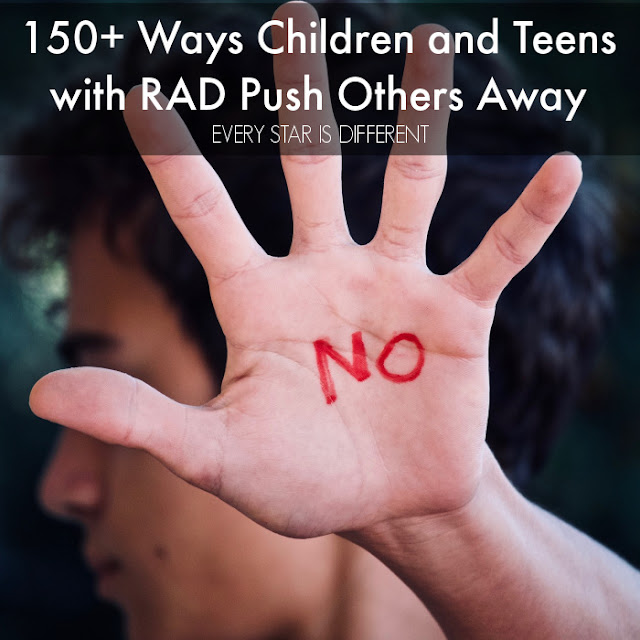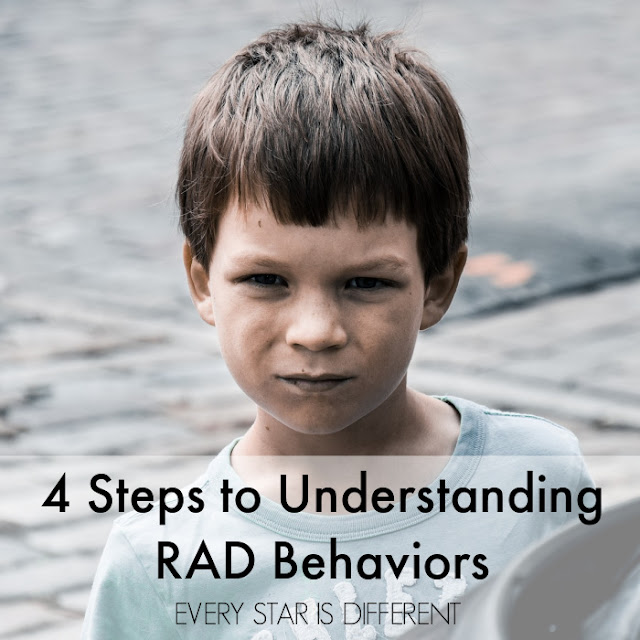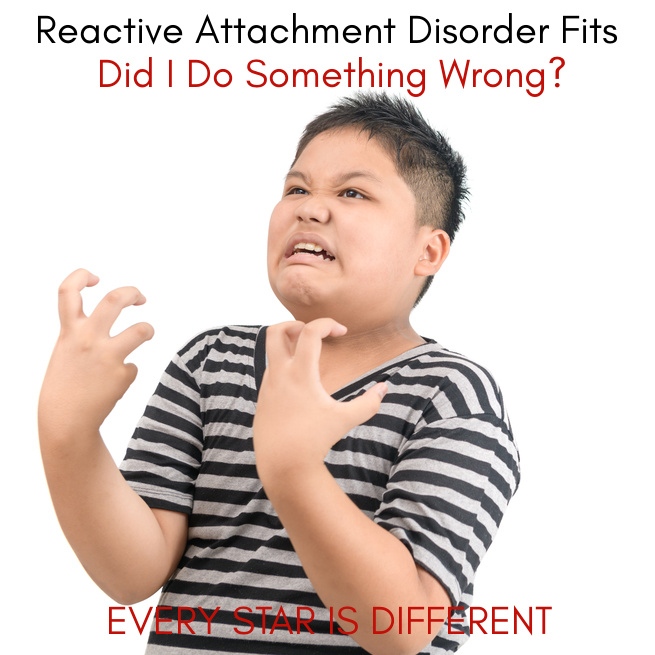Children with RAD are victims of abuse and/or neglect.
Behaviors associated with Reactive Attachment Disorder are due to how the brain forms while the innocent child is surviving trauma.
It is our goal to support healthy and loving families where children with RAD can heal, if possible.
What Is Reactive Attachment Disorder
Behaviors associated with Reactive Attachment Disorder are often quite severe but do vary.
Like autism, Reactive Attachment Disorder is on a spectrum.
No two children are alike.
At the same time, children and teens with Reactive Attachment Disorder seem to follow similar behavior patterns and themes.
For a better explanation of what this spectrum of RAD may look like and what those patterns are, you can read the resource below.
The Worst Cases of Reactive Attachment Disorder
Many children and teens may exhibit behaviors similar to those of a child with Reactive Attachment Disorder at one time or another.
One difference between typical child and teen behavior compared to RAD behavior is the frequency and intensity of behaviors.
Children and teens with Reactive Attachment Disorder exhibit behaviors frequently (more often than not), with an ability to paralyze life and jeopardize the safety of others and/or self on a regular basis.
Another difference is that a child and teen with Reactive Attachment Disorder display behaviors in almost every RAD category/theme on a regular basis, not just a few categories or even some categories.
RAD behaviors change over time based on the developmental, emotional, and cognitive abilities of children and teens.
Caregivers will see behaviors associated with Reactive Attachment Disorder that directly correlate with the developmental, emotional, and cognitive abilities of the child or teen AND where the child or teen lies on the RAD spectrum.
It can be incredibly difficult for caregivers to navigate what is and what is not a behavior associated with Reactive Attachment Disorder.
Often times children and teens with Reactive Attachment Disorder struggle with co-occurring developmental and emotional disabilities as well as the affects of drug and alcohol exposure in the womb.
To better understand how to determine if a behavior is related to Reactive Attachment Disorder or other challenge, be sure to read the resource below.
4 Steps to Understanding RAD Behaviors
There are MANY ways that children and teens with Reactive Attachment Disorder push others away.
Below is a list I've created based on:
1. Our family experiences in the home
2. Experiences our family has experienced while our youngest has gone through multiple residential placements
3. Experiences of friends, who are caregivers of children with Reactive Attachment Disorder
Caregivers may experience their RAD child or teen push away in other ways not listed below.
150+ Ways Children and Teens with RAD Push Others Away
Pathological Lying
- Triangulation
- Blaming others for situations that the RAD child did or instigated
- Denial of actions, even with witnesses
- Lying to family members
- Lying to peers
- Lying to adults outside of the home including therapists, teachers, etc.
- Reporting false injuries or sicknesses
- Refusing to report injury or sickness
- Injuring self and reporting it as accident
- Denial of knowledge and skills
Chronic Stealing
- Stealing food
- Stealing objects
- Stealing weapons
- Stealing valuables and electronics
- Stealing clothing items
- Stealing personal information and important papers
- Stealing money
- Stealing medication, alcohol, an drugs
- Physically taking items from others, claiming ownership
Hoarding
- Hoarding food
- Hoarding objects
- Placing items in heat vents, in between walls, etc.
Food Issues
- Refusing to eat
- Gorging and over stuffing
- Making extra noise when eating and chewing
- Refusing to chew with mouth closed
- Being extra messy with food
- Refusing to use utensils with food
- Refusing to use napkins or paper towels to wipe face while eating
- Spilling food and drink
- Demanding more food
- Demanding other food
- Eating other people's food
- Over the top food experimentation
- Unkind words and actions towards others during mealtime
- Wetting, soiling or other inappropriate behaviors at the table
- Lack of safety with self and others at mealtime
- Throwing food, plates, bowls, & utensils
Verbal Attacks
- Name calling
- Excessive teasing others with words
- Bullying others with words
- Mocking others with words
- Screaming at others
- Yelling at others
- Swearing at others
- Sexually inappropriate words towards others
- Constant interruptions
- Excessive and inappropriate loud laughter
- Provoking others through words
- Incessant talking
- Verbally demanding that things happen NOW
- Argumentative and defiant in conversations
Destruction of Property and Vandalism
- Wetting clothing repeatedly
- Wetting furniture repeatedly
- Wetting in secret places and hiding it
- Soiling clothing and bedding repeatedly
- Soiling furniture repeatedly
- Soiling in secret places and hiding it
- Spreading fecal matter
- Use of objects as weapons to destroy property
- Use of weapons to destroy property
- Misuse of items to destroy property
- Emptying or destroying products so others can't use them
- Flooding bathroom and other rooms in home
- Breaking toilet and other household fixtures
- Punching and kicking walls
- Punching and kicking doors
- Punching and kicking furniture
- Breaking windows
- Breaking doors
- Breaking furniture
- Breaking electronics
- Breaking appliances
- Misusing light fixtures
- Starting fires
- Tearing and shredding clothing
- Tearing and shredding stuffed animals, sheets, and blankets
- Throwing objects and furniture
- Drawing on objects, furniture, walls, etc.
Self-Injurious Behaviors
- Refusing to take medications
- Refusing to follow doctor's orders
- Refusing to let others take care of you when sick or injured.
- Refusal to sleep
- Refusal to eat
- Self-harming using household objects
- Self-harming using sharp objects
- Self-harming using weapons
- Self-harming using medications and illegal substances
- Choosing to put self in unsafe situations with others
- Choosing to put self in unsafe environments
Cruelty to Animals
- Refusing to follow appropriate personal boundaries with animals
- Throwing animals
- Poking at animals
- Throwing items at animals
- Putting animals in unsafe places
- Hitting, kicking, and/or punching animals
- Stepping on animals
- Denying food and water to animals
- Neglecting animals
- Provoking animals to hurt self and/or others
- Harming animals using objects
- Harming animals using weapons
Cruelty to Others
- Refusing to follow appropriate personal boundaries with others
- Bumping into others
- Pushing others
- Throwing others
- Poking others
- Choking others
- Throwing items at others
- Putting others in unsafe places
- Hitting others
- Kicking others
- Punching others
- Pulling the hair of others
- Denying food and water to others
- Destroying property of others
- Discarding property of others
- Provoking others to hurt self and/or other people
- Harming others using objects
- Harming others using weapons
- Threatening to harm another
- Threatening behaviors
- Instigating conflict with others
- Taking objects away from others
- Negative facial expression towards others.
- Manipulation towards others
- Refusing to share with others
- Refusing to give and/or receive gifts
- Destroying gifts from and to others.
Fire Setting
- Using matches, lighters or other fire starters
- Using light fixtures and other electrical options
- Using appliances inappropriately so they overheat
- Using electronics, cellphones, batteries, etc.
- Using gasoline, oil, and other flammable objects
- Putting items in heat vents
Sexual Behaviors
- Inappropriate personal boundaries with adults
- Inappropriate personal boundaries with children
- Inappropriate personal boundaries with animals
- Inappropriate acting out in the presence of others
- Assault towards adults
- Assault towards children
- Assault towards animals
- Engaging in inappropriate online activities
Angry Rages, Physical Aggression and Violence
- Screaming at very loud and/or high pitches
- Dissociation during inappropriate and dangerous behaviors
- Blacking out during inappropriate and dangerous behaviors
- Verbal aggression towards others
- Physical aggression towards others
- Destruction of property
Defiance
- Refusing to allow others to teach rules, skills, etc.
- Refusing to allow others to help with everything and anything.
- Refusing to do things independently.
- Refusing to follow directions
- Refusing to respect personal boundaries
- Refusing to take care of self and listen to body
- Refusing to practice proper hygiene
- Refusing to use manners
- Always needs to be right
- Always needs to win
- Demanding that things happen NOW
- Refusing to participate in family functions
- Refusing to go to school
- Refusing to see medical professionals
Eloping
- Running away from home
- Running away from school
- Running away from friends' or neighbors' homes
- Running away from public places
- Running out of a room
- Refusing to stay in a designated location
- Running after and/or going with strangers
Unless you are a caregiver of a child or teen with Reactive Attachment Disorder, one can't begin to understand what it is like trying to raise and love a child who constantly pushes away in the most extreme ways.
It is so easy to think that you as the caregiver are the problem.
As a caregiver of two children with Reactive Attachment Disorder, I would never wish the experience on anyone.
We have personally experienced 95% of the push away behaviors listed above.
Caregivers carry on, despite the family being abused in multiple ways because they have hope that the RAD brain can heal.
If they can just hang on long enough...
Caregivers continue to show love, because that's all anyone can do, even if it's not enough.
Treatment for Reactive Attachment Disorder is challenging and is never guaranteed to work.
RAD Treatment for Children
The system is not set up to help families struggling with Reactive Attachment Disorder.
With all that said, it is so important to remember...
Reactive Attachment Disorder behaviors are not the child's fault.
They are not intentional.
Behaviors directed at the caregiver, family members and others close, can feel extremely personal.
Know that you are not alone.
What you're experiencing is real.
If you enjoyed this post, you may also like the resources below.



















.jpg)
No comments:
Post a Comment